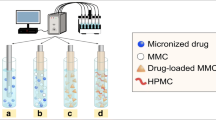Abstract
A microscopic mass balance approach has shown that the initial saturation (Is), absorption number (An), dose number (Do), and dissolution number (Dn) are four fundamental dimensionless parameters that can be used to estimate the fraction dose absorbed (F) of suspensions of poorly soluble drugs in humans. The dissolution number of a drug increases with decreasing its particle size. The effect of micronization onF for suspensions was investigated in terms ofDn. About 90% of maximalF can be achieved atDn≈2. Increasing the solubility of a drug results in better oral absorption through increasingDn and decreasingDo. The fractions dose absorbed of digoxin, griseofulvin, and benoxaprofen agree with predictedF values using estimated parameters. Drugs with lowDo and lowDn can be more completely absorbed by reducing particle size, while absorption of drugs with highDo and lowDn is limited by solubility and requires higher solubility to enhance the fraction dose absorbed in addition to micronization. Solubility at the physiological pH should be used for the estimation of the fraction dose absorbed.
Similar content being viewed by others
References Cited
Abdou, H.M.,Dissolution, Bioavailability, and Bioequivalence, Easton, Mack, 1989.
Atkinson, R.M., Bedford, C., Child, K.L. and Tomich, E.G., The effect of griseofulvin particle size on blood levels in man.Antibiotics and Chemotherapy, 12, 232–238 (1962).
Dressman, J.B., Kinetics of drug absorption from the gut, In J.G. Hardy, S.S. Davis and C.G. Wilson (eds.),Drug Delivery to the Gastrointestinal Tract. Ellix Horwood Limited, Chichester, 1989, pp. 195–219.
Gibaldi, M.,Biopharmaceutics and clinical pharmacokinetics. 3rd ed., Lea & Febiger, Philadephia, 1984, pp. 44–63.
Johnson, B.F., O’Grady, J. and Bye, G., The influence of digoxin particle size on absorption of digoxin and the effect of propantheline and metoclopramide.Br. J. Clin. Pharmac., 5, 465–467 (1978).
Jounela, A.J., Pentikäinen, P.J. and Sothmann, A., Effect of particle size on the bioavailability of digoxin.Europ. J. Clin. Pharmacol., 8, 365–370 (1975).
Khalafalla, N., Elgholmy, Z.A. and Khalil, S.A., Bioavailability of different brands of griseofulvin tablets and its correlation to dissolution data.Pharmazie, 35, 482–484 (1980).
Leeson, L.J. and Carstensen, J.T.,Dissolution Technology. The Industrial Pharmaceutical Technology Section of the Academy of Pharmaceutical Science, Washington, D.C., 1974.
Miyazaki, S., Yamahira, T., Inoue, H. and Nadai, T., Interaction of drugs with bile components. II. Effect of bile on the absorption of indomethacin and phenlbutazine in rats.Chem. Pharm. Bull., (Tokyo) 28, 323–326 (1980).
Nash, J.F., Carmichael, R.H., Ridolfo, A.S. and Spradlin, C.T., Pharmacokinetic studies of benoxaprofen after therapeutic doses with a review of related pharmacokinetic and metabolic studies.J. Rheumat. Suppl., 6, 12–19 (1980).
Oh, D.-M., Curl, R.L. and Amidon, G.L., Estimating the fraction dose absorbed from suspensions of poorly soluble compounds in humans: a mathematical model.Pharm. Res., 10, 264–270 (1993).
Oh, D.-M., and Amidon, G.L., Prediction of drug-drug interaction during oral absorption of carrier-mediated compounds in humans.Arch. Pharm. Res., 17, 364–370 (1994).
Poelma, F.G.J.,Intestinal Absortion of Drugs: The Influence of Taurocholate on the Absorption of Drugs in the Small Intestine of the Rat, Ph.D. Thesis, The University of Utrecht, The Netherlands, 1989.
Ridolfo, A.S., Thompkins, L., Bechtol, L.D. and Carmichael, R.H., Benoxaprofen, a new anti-inflammatory agent: particles-size effect of dissolution rate and oral absorption in humans.J. Pharm. Sci., 68, 850–852 (1979).
Shaw, T.R.D. and Carless, J.E., The effect of particle size on the absorption of digoxin.Eur. J. Clin. Pharmacol., 7, 269–273 (1974).
Sinko, P.J., Lessman, G.D. and Amidon, G.L., Predicting fraction dose absorbed in humans using a macroscopic mass balance approach.Pharm. Res., 8, 979–988 (1991).
Terhaatg, B., Petit, G.L., Pachaly C. and Feller, K., Thein vitro liberation and the bioavailability of different brands of griseofulvin in plasma and urine in man.Int. J. Clin. Pharmacol. Ther. Toxicol., 23, 475–479 (1985).
Wolen, R.L., Carmichael, R.H., Ridolfo, A.S., Thompkins, L. and Ziege, E.A., The effect of crystal size on the bioavailability of benoxaprofen: studies utilizing deuterium labreled drug.Biomed. Mass Spectrometry, 6, 173–178 (1979).
Author information
Authors and Affiliations
Rights and permissions
About this article
Cite this article
Oh, DM., Curl, R.L., Yong, CS. et al. Effect of micronization on the extent of drug absorption from suspensions in humans. Arch. Pharm. Res. 18, 427–433 (1995). https://doi.org/10.1007/BF02976347
Received:
Issue Date:
DOI: https://doi.org/10.1007/BF02976347




